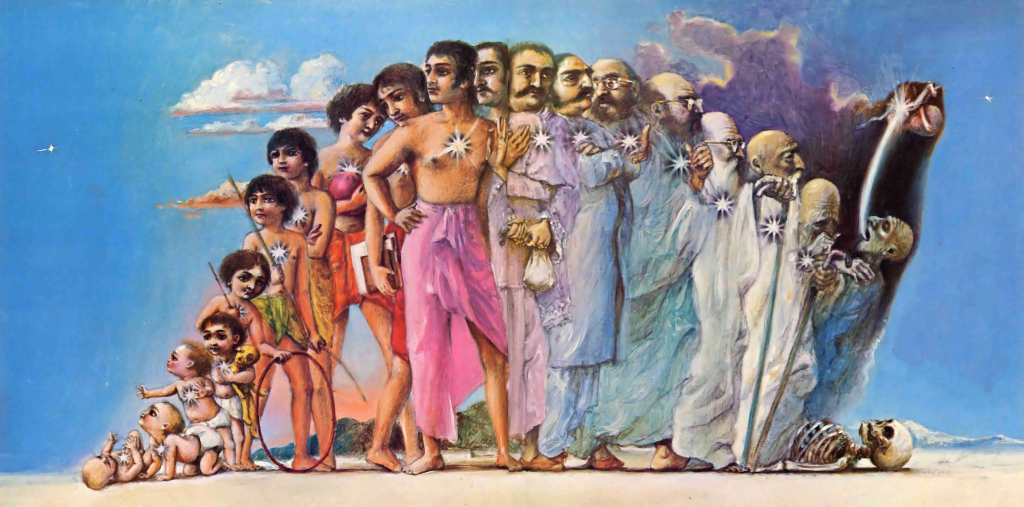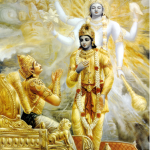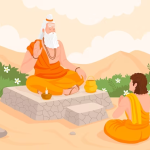Summary of Bhagavad Gītā: Chapter 2 – The scene is set, the armies are ready, the bugles have been blown and the warriors are impatient to show their valor. However, a strange calamity has befallen our hero Arjuna. He is completely disturbed, in fact depressed, with tears in his eyes. He doesn’t want to fight and is now seeking the help of his dear-most friend, the Supreme Lord Śrī Kṛṣṇa.
On seeing such a pitiful situation of His dear friend & devotee. Kṛṣṇa, the Supreme Personality of Godhead, questioned Arjuna, “How can such weakness of heart, such impotency, come at such a crucial point of time?”. Hearing this, Arjuna tried to justify his desire to leave the battle. He said, “O killer of enemies, O killer of Madhu, how can I shoot arrows towards my worshipable – Bhīṣma and Droṇa?”
Arjuna wanted to leave the battle, for he thought that the victory would be tainted with the blood of his loved ones. Being so confused, he finally surrendered to Lord Kṛṣṇa and accepted the Lord as his Guru. This marks the first lesson in spirituality i.e. when we are surrounded by doubts. We should surrender to higher spiritual authority.
Table of Contents
Fundamental question answered: ‘Who am I?’
Lord Kṛṣṇa immediately assumed the role of the Guru and spoke the fundamental truth about every living being. He told Arjuna that he is worrying about that which is not worthy of being thought upon. Lord Kṛṣṇa said, “Never was there a time when I did not exist, nor you, nor all these kings; nor in the future shall any of us cease to be.” Thus confirming the eternity of living beings, Lord further explained that we are continuously changing bodies – from a child to a youth, and further to an old man. Hence, the change of body is nothing new for us, and at the time of death, we change to a completely different body.

It is important to note here that the message of Lord Kṛṣṇa is non-sectarian and is not reserved exclusively for a particular ethnicity, religion, or tribe. Being the Supreme Lord, Kṛṣṇa gave the top view of reality, a perspective that can only be provided by someone who is Himself outside the material reality and is its creator. Lord Kṛṣṇa then continued enlisting various properties of the living entity, irrespective of the species, and told that every living entity is fundamentally a particle of bliss, consciousness, and knowledge.
The soul is indestructible!
People watch movies that show superheroes that can take bullets in their chests and still roam unaffected. They cheer for the invincibility of the imaginary characters, so much so that superhero movies earn crores all over the world. But what if we all have such powers?
While explaining the various properties of the spirit soul, Lord Kṛṣṇa told Arjuna that the soul is of such nature that no weapon can cut it, burn it, dissolve it, or cleave it. In fact, nothing can kill us, who are the divine fragments of the Supreme Lord Kṛṣṇa. Thus, Lord Kṛṣṇa argued that Arjuna should not worry about the death of relatives while carrying out his duties, for such a death is simply a change of dress.
Lord Kṛṣṇa pointed out that while carrying out important duties. There will be phases of happiness & distress which can be compared to seasons like summer and winter. However if one simply develops the tolerance to bear them then such a person is fit to go beyond time, to become free from the world of duality.
Mysticism of yoga
After explaining the theoretical or analytical (sāṅkhya-yoga) aspect of the soul’s nature. Lord Kṛṣṇa began the practical or action-based (karma-yoga) explanation.
He tells that the secret to performing an action without getting entangled in its reactions is to renounce the idea of doership. One should understand that he/she is not Supreme but the loving servitor of the Supreme Lord. Lord Kṛṣṇa is the Supreme Absolute Truth and when we get connected to Him, we also become happy.
Further, Lord Kṛṣṇa explains that one should not hanker for the results of the actions. The running after the results is due to our misidentification i.e. we are this body that is limited to one life. Due to such misunderstanding, one tries to enjoy as much as possible. Thus keeps on getting entangled in the network of karma. However, if one becomes equipoised, with both success and failure, one becomes free from the reaction of karma. Actually, it is karma only which has bound us in this world.

It is important to understand here that while explaining the karma yoga. I.E Action is done without considering oneself as the doer, Lord Kṛṣṇa advises Arjuna to use his intelligence properly. This transcendental use of intelligence or buddhi-yoga is recommended to accept the existence of a higher power than us. To accept our limitations, and to naturally accept our humble position as the servant of the Absolute Truth. When one does so, one automatically becomes free from all anxieties as one becomes situated in his natural position. This is the real purpose of yoga i.e. ‘union with the Supreme’.
Sthita-prajña: Fixed in transcendence
Hearing all this, Arjuna asks, “What does such a person, who has consciousness fixed in the transcendence, look like? How does he talk? How does he act?” Such a person is technically called sthita-prajña. Arjuna’s questions are important because he didn’t want mere theoretical knowledge but practical application.
Lord Kṛṣṇa continued, “One who is able to withdraw his senses from sense objects. As the tortoise draws its limbs within the shell, is firmly fixed in perfect consciousness.” This is an important consideration because only when one understands. That he is beyond the body made up of senses, one can withdraw them. Thus, one doesn’t have to just theoretically think that he/she is not the body, rather one should feel it daily. And when one does so, one becomes fixed in transcendence.
Lord Kṛṣṇa tells that such a person is actually so wonderful that it appears that he is totally opposite from the normal population. What everyone thinks of as night is seen by a person fixed in transcendence as daytime, and vice-versa. This is so because such a person sees things as they are. Thus, when the majority of the population engages in mindless sense gratification, sthita-prajña refrains from acting. Similarly, when everyone is engaged in sleeping, sthita-prajña utilizes his/her time in self-realization.
At the end of the chapter, Lord Kṛṣṇa reveals the method to cross, to go beyond this world of birth, death, old age, and disease. He tells that a person is free from the desire to enjoy, who doesn’t see oneself as a doer who attains lasting peace. Further, if one remains like this at the time of death, one can enter into the Kingdom of God.





